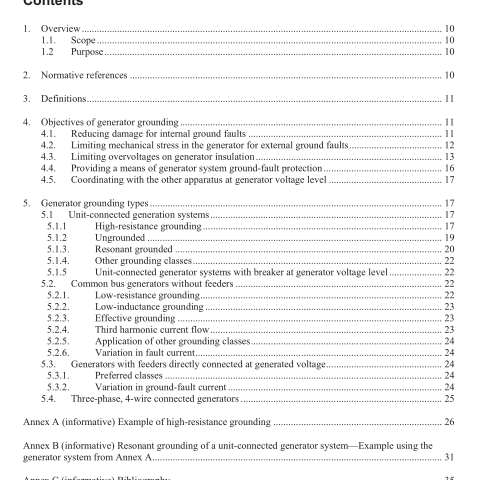IEEE C62.92.2-2017 pdf download.IEEE Guide for the Application of Neutral Grounding in Electrical Utility Systems, Part II—Synchronous Generator Systems
It should be noted that the ground-fault current depends not only on the generator grounding, but also on other sources of ground current available to the generator. The last three classes have substantially higher fault current levels than ungrounded, resonant grounded, and high-resistance grounded classes (see IEEE Std C62.92.1 [B18], Table 1, for more information).
In addition to the normal shutdown sequence (e.g., tripping the generator breaker, prime mover, and excitation) initiated by the machine protective relays, other measures are sometimes used to reduce the magnitude and duration of the fault current after the ground-fault relay has operated. These measures include forced field reduction and the use of automatic neutral circuit breakers. Automatic neutral circuit breakers are used for comparatively small machines. When a neutral generator breaker is used, the Transient Recovery Voltage (TRV) characteristics of the breaker shall be considered. Where automatic neutral circuit breakers are applied, it is their function to interrupt heavy currents during a single phase-to-ground fault within the generators, thereby minimizing damage in the generator.
Opening of the neutral ground connection will change the system parameters of X 0 /X 1 and R 0 /X 1 and result in higher than normal temporary overvoltages on the un-faulted phases that can cause serious damage in other parts of the system. After the main circuit breaker has been tripped, the fault current will continue to flow as long as the fault circuit exists and until field flux in the generator decays to zero. Reduction of armature fault current can be accomplished with forced field reduction of the excitation system.
Forced field reduction can be accomplished in several different ways (Berdy, Crenshaw, and Temoshok [B4]). The decay rate of the generator field flux determines the rate of reduction in generator fault current.
4.2. Limiting mechanical stress in the generator for external ground faults Fault current limiting devices are generally required for machines manufactured in accordance with the following standards:
a) ANSI C50.10-1977
b) IEEE Std C50.12-2005
c) IEEE Std C50.13-2014
Prior to the original versions of these standards, no fault current limiting device was required in the generator neutral. Meeting the limitation of IEEE Std C50.12-2005 and IEEE Std C50.13-2014 requires that at least a minimum value of impedance, either a resistance or a reactance, be installed in the neutral of all wye- connected grounded generators where the zero-sequence reactance is less than the positive-sequence subtransient reactance.
In calculating the maximum currents that can flow in the generator windings during an external fault, it is usually sufficient to consider the generator impedances alone. It can be shown that, if sufficient neutral impedance is used to make the phase-to-ground fault current less than or equal to the three-phase fault current with the machine isolated from the system, the winding currents for any fault will be less than or equal to the winding current for a three-phase fault (Brown [B5]).
4.3. Limiting overvoltages on generator insulation The class of grounding also affects generator overvoltage protection in controlling the magnitude of temporary and transient overvoltages during a ground-fault and, consequently, determines the minimum rating of surge arresters that can be employed. These considerations are common to the grounding of all types of apparatus. The available classes of grounding may be ranked as follows in order of increasing temporary overvoltages assuming a fault resistance that yields the highest coefficient of grounding, but neglects the effects of restrikes within a solid dielectric (Brown, Johnson, and Stevenson [B6]):
a) Effectively grounded
b) Low-inductance grounded
c) Low-resistance grounded
d) Resonant grounded
e) High-resistance grounded
f) Ungrounded.IEEE C62.92.2 pdf download.IEEE C62.92.2-2017 pdf download
IEEE C62.92.2-2017 pdf download

Leave a Reply